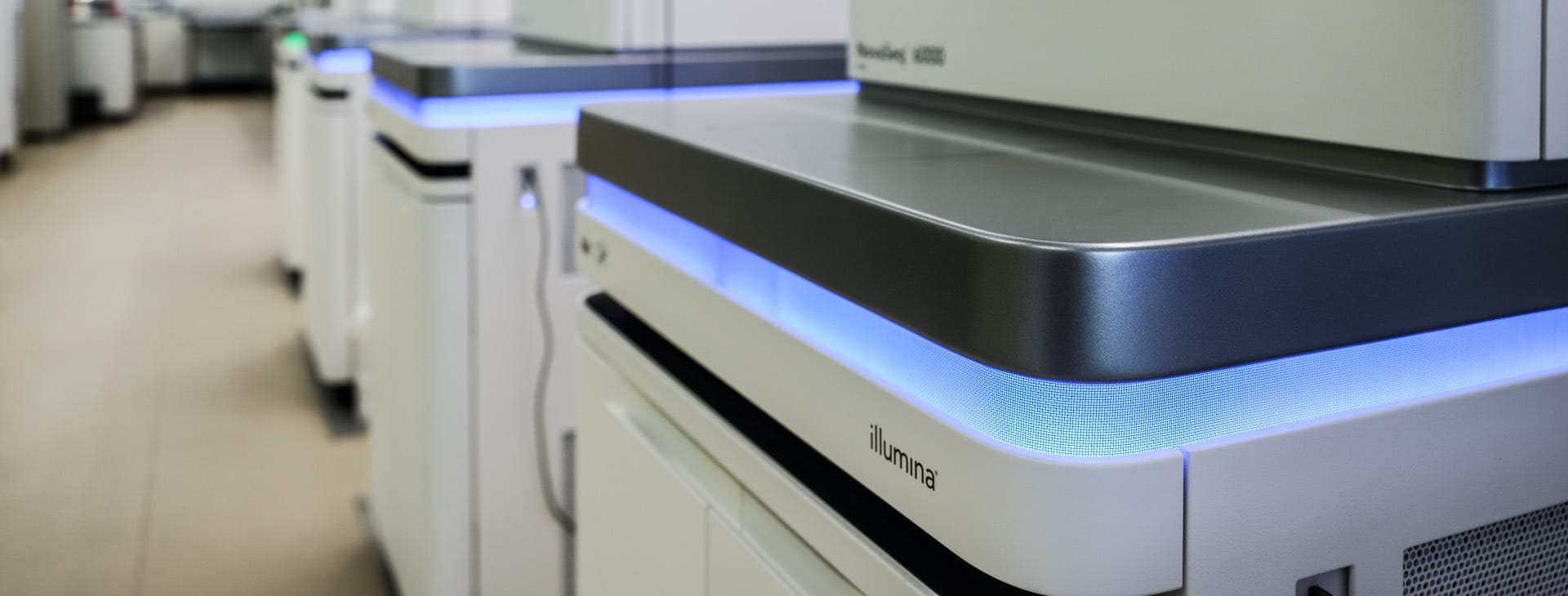What is the Illumina method of DNA sequencing?
Short-read sequencing using Illumina NovaSeq 6000s in the Bridget Ogilvie Building. Photo taken by Greg Moss of Greg Moss Photography in 2019. Image credit: Greg Moss / Wellcome Sanger Institute

Illumina sequencing launched in 2006, allowing scientists to sequence 1 million bases of DNA in one single run.
- Illumina sequencing is a type of next generation sequencing that launched in 2006.
- It generates many millions of highly accurate reads making it much faster and cheaper than other available sequencing methods at the time.
- The principles are still used well into the 2020s.
What is the Illumina method of DNA sequencing?
- Illumina sequencing launched in 2006, initially under the name the ‘Genome Analyzer’. It was bought by Illumina in 2007, leading to its name change.
- The Illumina method is a type of next generation sequencing technology.
- It has been used to sequence many genomes and has enabled the comparison of DNA sequences to improve understanding of health and disease.
- Illumina sequencing machines have continued to improve in speed and sequencing capacity, and are one of the most popular machine types.
How does the Illumina method of DNA sequencing work?
- The first step is to break up the DNA into more manageable fragments of around 200 to 600 base pairs.
- Short sequences of DNA, called adaptors, are attached to the DNA fragments.
- The DNA fragments attached to adaptors are then made single stranded by incubating them with sodium hydroxide.
- Once prepared, the DNA fragments are washed across the sequencing chamber, called a flow cell. The complementary DNA binds to primers on the surface of the flow cell and DNA that doesn’t attach is washed away.
- The DNA attached to the flow cell is then replicated to form small clusters of DNA with the same sequence. When sequenced, each cluster of DNA molecules will emit a signal that is strong enough to be detected by a camera.
- Unlabelled nucleotide bases and DNA polymerases are then added to lengthen and join the strands of DNA attached to the flow cell. This creates ‘bridges’ of double-stranded DNA between the primers on the flow cell surface.
- The double-stranded DNA is then broken down into single-stranded DNA using heat, leaving several million dense clusters of identical DNA sequences.
- Primers and fluorescently-labelled terminators (terminators are a version of nucleotide base – A, T, C or G – that stop DNA synthesis) are added to the flow cell.
- The primer attaches to the DNA being sequenced.
- The DNA polymerase then binds to the primer and adds the first fluorescently labelled terminator to the new DNA strand. Once a base has been added no more bases can be added to the strand of DNA until the terminator base is cut from the DNA.
- Lasers are passed over the flow cell to activate the fluorescent label on the nucleotide base. This fluorescence is detected by a camera and recorded on a computer. Each of the terminator bases (A, T, C or G) give off a different colour.
- The fluorescently labelled terminator group is then removed from the first base and the next fluorescently labelled terminator base can be added alongside. And so, the process continues until millions of clusters have been sequenced.
- The DNA sequence is analysed base-by-base during Illumina sequencing, making it a highly accurate method.
- The sequence generated can then be aligned to a reference sequence, this looks for matches or changes in the sequenced DNA.
- Watch how the technique works here.
What are the benefits and limitations of the Illumina method of DNA sequencing?
- Illumina sequencing has four basic benefits as a second generation sequencing technology:
- It can generate many millions of short reads at the same time.
- It is much more cost effective than earlier techniques.
- It is much faster than earlier techniques.
- Like with capillary sequencing, the sequencing output is directly detected without the need for gel electrophoresis.
- Over time, sequencing technologies have continued to evolve – and later generation techniques can produce longer fragments of DNA (called long reads). However, Illumina has continued to be used well into the 2020s.